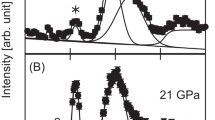Abstract
It is possible in principle that hydrogen and oxygen can evolve during the explosive instability of ice leading to its disintegration into micro-and nanofragments, which takes place under the conditions of strong nonuniform compression in the region of high pressures. The nature of the anticipated phenomenon can be related to the electron-and ion-induced sputtering and dissociation of nanodimensional ice fragments. Electrons and ions can be generated in the course of an explosive instability in ice, which is developed as a result of fractoemission, triboemission, and secondary electron emission. The yield Y of hydrogen, oxygen, and related radicals is expected to depend as Y ∝ P 2 on the threshold pressure P at which the explosive instability of ice is manifested.
Similar content being viewed by others
References
E. G. Fateev, Pis’ma Zh. Éksp. Teor. Fiz. 73, 482 (2001) [JETP Lett. 73, 432 (2001)].
P. W. Bridgman, Phys. Rev 48, 825 (1935).
V. T. Fedorov and Kh. B. Khokonov, Dokl. Akad. Nauk SSSR 300, 1126 (1988) [Sov. Phys. Dokl. 33, 463 (1988)].
B. V. Deryagin, N. A. Krotova, and V. P. Smilga, Adhesion of Solid (Nauka, Moscow, 1973; Consultants Bureau, New York, 1978).
M. I. Molotskii and S. Z. Shmurak, Phys. Status Solidi A 120, 83 (1990).
M. I. Molotskiĭ and V. B. Malyugin, Fiz. Tverd. Tela (Leningrad) 25, 2892 (1983) [Sov. Phys. Solid State 25, 1668 (1983)].
K. Biedrzycki and J. Madar, and B. Sujak, Radiat. Prot. Dosim. 4, 247 (1983).
D. A. Fifolt, V. F. Petrenko, and E. M. Schulson, Phil. Mag. B 67, 289 (1993).
Y. Mizuno and T. Mizuno, Can. J. Phys. 81, 71 (2003).
T. I. Quickenden, B. J. Selby, and C. G. Freeman, J. Phys. Chem. A 102, 6713 (1998).
T. Ya. Gorazdovskiĭ, Pis’ma Zh. Éksp. Teor. Fiz. 5, 78 (1967) [JETP Lett. 5, 64 (1967)].
M. A. Yaroslavskiĭ, Rheological Explosion (Nauka, Moscow, 1982) [in Russian].
Solid under Pressure, Ed. by W. Paul and D. M. Warshaner (McGraw-Hill, New York, 1963).
J. T. Dickinson, E. E. Donaldson, and M. K. Park, J. Mater. Sci. 16, 2897 (1981).
G. A. Kimmel and T. M. Orlando, Phys. Rev. Lett. 77, 3983 (1996).
G. R. Floyd and R. H. Prince, Nature 240, 345 (1972).
M. Michaud, A. Wen, and L. Sanche, Radiat. Res. 159, 3 (2003).
R. A. Baragiola, R. A. Vidal, W. Svendsen, et al., Nucl. Instrum. Methods Phys. Res. B 209, 294 (2003).
M. I. Molotskiĭ, Fiz. Tverd. Tela (Leningrad) 19, 642 (1977) [Sov. Phys. Solid State 19, 374 (1977)].
J. Herring, A. Aleksandrov, and T. M. Orlando, Phys. Rev. Lett. 92, 187602 (2004).
M. T. Sieger, W. C. Simpson, and T. M. Orlando, Natura 394, 554 (1998).
W. L. Brown, L. J. Lanzerotti, J. M. Poate, et al., Phys. Rev. Lett. 40, 1072 (1978).
G. A. Kimmel, T. M. Orlando, P. Cloutier, et al., J. Phys. Chem. B 101, 6301 (1997).
M. Shi, D. E. Grosjean, J. Schou, et al., Nucl. Instrum. Methods Phys. Res. B 96, 524 (1995).
A. Bar-Nun, G. Herman, M. L. Rappaport, et al., Surf. Sci. 150, 234 (1985).
W. L. Brown, W. M. Augustyniak, L. J. Lanzerotti, et al., Phys. Rev. Lett. 45, 1632 (1980).
E. A. Brener, H. Müller-Krumbhaar, and R. Spatschek, Phys. Rev. Lett. 86, 1291 (2001).
N. H. Flether, The Chemical Physics of Ice (Cambridge Univ. Press, Cambridge, 1970).
A. P. Radliński, E. Z. Radlińska, M. Agamalian, et al., Phys. Rev. Lett. 82, 3078 (1999).
M. Arakawa, Icarus 142, 34 (1999).
H. Kimura and I. Mann, Earth, Planets, Space 51, 1223 (1999).
L. Scudiero, J. T. Dickinson, and Y. Enomoto, Phys. Chem. Miner. 25, 566 (1988).
B. C. Garrett, D. A. Dixon, D. M. Camaioni, et al., Chem. Rev. 105, 355 (2005).
E. G. Fateev, Zh. Tekh. Fiz. 75(2), 53 (2005) [Tech. Phys. 50, 193 (2005)].
K. Nakayama, H. Hashimoto, and T. Susuki, J. Phys. D 25, 303 (1992).
N. Timneanu, C. Caleman, J. Hajdu, et al., Chem. Phys. 299, 277 (2004).
P. Yu. Butyagin, Usp. Khim. 53, 1769 (1984).
V. V. Boldyrev, Izv. Akad. Nauk SSSR, Ser. Khim., No. 10, 2228 (1990).
Author information
Authors and Affiliations
Additional information
Original Russian Text © E.G. Fateev, 2006, published in Pis’ma v Zhurnal Tekhnicheskoĭ Fiziki, 2006, Vol. 32, No. 23, pp. 15–24.




